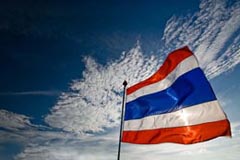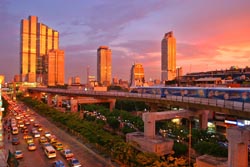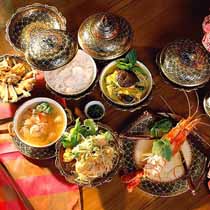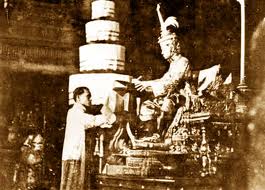on Advances in Information Technology
December 6-7, 2012 Bangkok, Thailand

Contact Us
- iait@sit.kmutt.ac.th
- http://www.iait-conf.org
- Ekapong Jungcharoensukying
Tel: 0-2470-9817 - Wannida Soontreerutana
Tel: 0-2470-9896 - Fax: +66-2872-7145
Past Conferences
- IAIT2010 November 4-5
- CSBio2010 November 3-5
- IAIT2009 December 1-5
- ICONIP2009 December 1-5
- IAIT2007 November 1-2
- IAIT2005 November 25-26
- NCIT2006 November 2-3
- NCEB2006 November 2-3
Organizer:
Sponsors:








Other Interesting Conferences:


Thailandís national flag, ceremoniously raised each morning in every town and village, is composed of five horizontal bands of red, white, and blue. Outer bands of red representing the nation enclose equal inner bands of white, evoking religion. The blue band, occupying the central one - third of the total area, symbolizes the monarchy. The harmony of design expresses the complementary nature of these three pillars of the Thai nation.
This tri-colored flag, called in Thai the "trirong", first introduced by King Vajiravudh (Rama VI) in 1917, succeeded an earlier design that placed a white elephant (emblem of the absolute monarch) on a red background.
Theravada Buddhism, the national religion, is the professed faith of Buddhist 94.2 percent, Muslim 4.6 percent, Christian 0.8 percent, others 0.4 percent of the population.
There is total religious freedom and all major religions can be found in practice.
The official national language, spoken by almost 100 percent of the population, is Thai, classified by linguists as belonging to a Chinese -Thai branch of the Sino -Tibetan family. It is a tonal language, uninflected, and predominantly monosyllabic. Most polysyllabic words in the vocabulary have been borrowed, mainly from Khmer, Pali, or Sanskrit. Dialects are spoken in rural areas.
Principal other languages are Chinese and Malay. English, a mandatory subject in public schools, is widely spoken and understood, particularly in Bangkok and other major cities.

Thailandís capital, known internationally as Bangkok but to Thais as Krung Thep (City of Angels), sprawls over an area of some 1,500 square kilometers on both sides of the Chao Phraya River. Established in 1782 by King Rama I, founder of the Chakri Dynasty, Bangkok has been the home of the Royal Family ever since.
Today, Bangkok is home to over 6 million people. Here also are located all government ministries, the police and military headquarters, the Supreme Patriarch of the Buddhist faith, the most prestigious universities and schools, the best medical facilities, important international organizations, and the greatest collections of art, museums, newspaper publishers, and television stations in the country.

Most Thai food is highly spiced, chili hot, and varies from region to region. The traditional ingredients of Thai food have changed little up to the present day, consisting largely of seafood and locally grown vegetables and fruits, a diet common to most of the country. What give the distinctive Thai flavor, and the differing taste from region to region, is the carefully blended sauces and chilies.
These go into dishes ranging from salty and bland soups to the spiciest salads and sweetest desserts, often all present within a single meal. The wide variety of Thai food tastes is a reflection of the combination of influences from various surrounding nations, which, with Thai ingenuity, have culminated in one of the world's favorite cuisines.
The Northeast is famous for its spicy dishes, but it really covers all taste extremes, being also strongly sour and salty. Its most famous dish, a regional staple that can also be found all over the country, is som tam, a Thai salad that simultaneously covers the four extremes of taste, and is eaten with a form of sticky rice.
The cuisine of the Central Plains has over the years come to include the influences of all the surrounding regions, and a meal usually includes everything from hot, spicy dishes to relatively bland ones. Here the sticky rice of the North is less common than plain rice, either steamed or fried. Many of the spicy soups, like tom yam and popular coconut milk curries, have their roots in this region.

Thailand is a fertile country, and agriculture, which broadly includes crop cultivation, forestry, livestock breeding, fisheries and mining, is the Thai economy's largest and most important sector.
Rice forms a staple part of the Thai diet; and while it is still the basis of the rural economy, it has been joined by newer, increasingly important export crops like sugar, tapioca, maize, pineapples, rubber and coconuts. Raw cotton and soybeans are also produced for export and tobacco production is on the rise. Vineyards have been planted and Thai vintners hope to turn out quality wines in due course.
Tropical fruits, including more than 20 varieties of edible bananas, are grown in abundance, and intensive livestock breeding includes cattle, poultry and swine rearing.
Thailand has a large fishing fleet operating from its 800-kilometer Indian Ocean and 1,800-kilometer Gulf of Thailand coasts. Thailand ranks among the world's top ten nations in the fishing industry in terms of total catch and export. Fishing is the third largest activity after crops and livestock.
Tin, fluorite, gypsum and lignite largely dominate Thailand's mining industry.
Thailand's currency is the baht, which is divided into 100 satang. Copper coins are valued at 25 and 50 satang, and silver ones at 1, 5, and 10 baht. Bank notes are valued at 20 (green), 50 (blue), 100 (red), 500 (purple), and 1,000 baht (gray); all denominations of bills are in different sizes.
Thailand is governed by a constitutional monarchy with His Majesty King Bhumibol Adulyadej as Head of State.

Official power rests with the government, personified by the Prime Minister, the Parliament, and a bureaucratic system that reaches down to the village level. Over past decades the Prime Minister's personal power has steadily increased, largely because of the Thai tendency to express their concerns to the highest-ranking authority, in nation as well as family. This frequently results in provincial delegations appearing at Government House requesting decisions on local problems. The Constitution is the highest law of the land, and provides for governing through a system of centralization.
Legislative power is vested in the Parliament, and exercised through a bicameral National Assembly consisting of the publicly elected House of Representatives and the Senate. The Parliament must approve all legislative matters of national policy, which then require the King's signature before becoming the law of the land.
|
Source by:www.swtravelagent.com Learn more about Thailand & Travel Destination Guide Please visit: www.tourismthailand.org |
«Back ^Top |